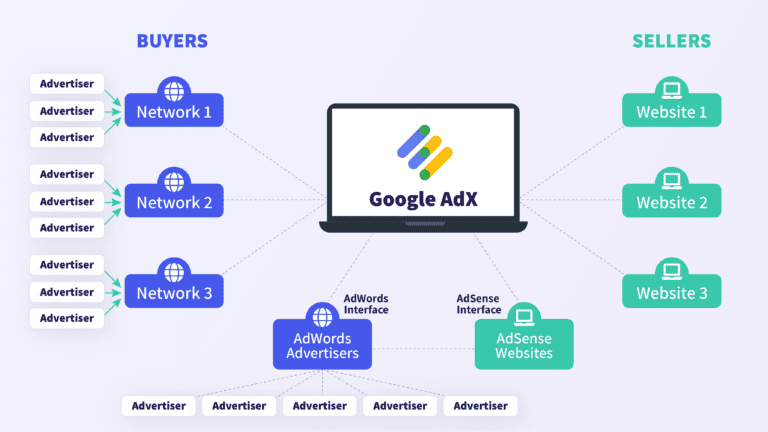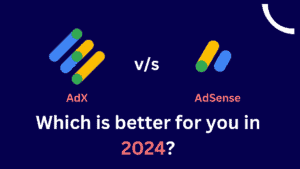"Which monetization tool should I use to yield higher ad revenue - AdX or AdSense?"
This is one of the most common dillema encountered by website owners and marketers. Google AdX vs AdSense are both advertising giants leading the digital marketing realm.
But as we plunge headlong into 2024, you might find yourself standing at an advertising crossroads, scratching your head, and asking, “Which one is for me?”
In the coming paragraphs, we’re going to dissect Google AdX vs AdSense, compare them side-by-side, and help you understand which one of these advertising behemoths will serve your specific needs better.
So, are you ready to join us on this deep dive into the world of Google AdSense and AdX?
Let’s get the ball rolling!
What is Google AdX?

Google AdX, officially known as Google Ad Exchange, is essentially a digital marketplace where advertisers and publishers buy and sell advertising space. Operating on a real-time bidding model, AdX allows advertisers to compete for ad space on websites that align with their target audience.
This allows for highly targeted ad placement, with the potential for increased ROI.
For publishers, Google AdX provides an opportunity to maximize ad revenue from their website’s content. Publishers can set minimum bids for their ad space, ensuring that they receive a fair price for their inventory.
Furthermore, AdX supports a wide variety of ad formats, including text, image, video, and rich media, giving publishers flexibility in how they monetize their content.
One of the key differentiators of Google AdX is its ability to facilitate programmatic direct deals and private auctions. These are advanced selling techniques not available in AdSense, giving publishers more control and potentially higher earnings.
However, it’s important to note that Google AdX is typically reserved for large publishers with a significant volume of high-quality traffic. To gain access to AdX, smaller publishers often need to go through a third party, like an ad management company.
What is Google AdSense?

Google AdSense, on the other hand, is a platform that allows bloggers, website owners, and other digital content creators to earn money by displaying Google ads on their sites. It operates on a simple pay-per-click and revenue-sharing basis.
Advertisers create ads through Google Ads and those ads are then distributed to the sites participating in AdSense.
AdSense is incredibly user-friendly, and even those with minimal technical knowledge can set it up. The platform automatically takes care of ad placement, choosing ads relevant to your content and audience.
For many beginners and small-to-medium-sized publishers, AdSense is the go-to platform for website monetization, thanks to its simplicity and lower traffic requirements compared to AdX.
In terms of ad formats, AdSense also supports a variety, including text, display, and rich media ads. However, it does not offer the advanced programmatic selling features that AdX does. Additionally, the earning potential on AdSense might be slightly lower due to less competitive bidding compared to AdX.
In essence, while Google AdX vs AdSense serve similar purposes, they cater to different needs and levels of sophistication within the world of digital advertising. Let’s compare the differentiating factors of both in detail.
Google AdX Vs Google AdSense
| Feature | Google AdX | AdSense |
| Ad Quality and Relevance | Higher ad quality due to premium advertisers, with a focus on relevance and engaging creatives. | Good ad quality, but may vary depending on the advertisers in the AdSense network. Relevance may not be as targeted as AdX. |
| User Interface and Ease of Use | Robust and feature-rich user interface tailored for larger publishers, offering advanced settings and controls. | User-friendly interface, suitable for a wide range of publishers, with a more simplified setup and management process. |
| Access to Advertisers | Provides access to a premium pool of advertisers, including major brands and agencies, fostering competition and potentially higher bids. | Accessible to a diverse range of advertisers, including smaller businesses, offering a broader but sometimes less competitive pool. |
| Targeting Options and Audience Reach | Extensive targeting options, including demographic, contextual, and behavioral targeting, allowing for precise audience segmentation. | Offers targeting options but may have fewer advanced features compared to AdX. Still provides effective audience reach and segmentation capabilities. |
| Reporting Features | Advanced reporting features, including real-time analytics, detailed performance metrics, and customizable reports for in-depth analysis. | Provides solid reporting features, though not as extensive as AdX. Offers essential performance metrics and insights for effective campaign monitoring. |
| Analytics Tools and Insights | Integrates with Google Analytics, providing comprehensive insights into user behavior, engagement, and ad performance. | Offers basic analytics tools and insights to help publishers understand ad performance and user interaction. May not be as comprehensive as AdX’s analytics integration. |
| Publisher Eligibility | Typically for larger publishers with high traffic and premium content. | Open to a wide range of publishers, including smaller websites and blogs. |
| Ad Types | Offers a variety of ad formats, including display, video, and native ads. | Primarily focuses on display ads but supports various ad formats, including text and link units. |
| Control and Customization | Provides more control over ad inventory, allowing publishers to set price floors, prioritize advertisers, and use advanced targeting options. | Limited control compared to AdX, but offers some customization options, including ad unit customization and category blocking. |
| Revenue Potential | Generally provides higher CPMs and potential for increased revenue due to premium advertisers and competition. | May have lower CPMs compared to AdX but is accessible to a broader range of publishers, making it suitable for smaller websites. |
| Ad Auctions | Uses a real-time auction system that allows advertisers to bid for ad impressions in real-time. | Uses an auction system but may not have the same level of competition as AdX, potentially resulting in lower bids. |
| Integration with Ad Manager | Seamlessly integrates with Google Ad Manager, providing a unified platform for managing ad inventory. | Can also be integrated with Ad Manager, but the level of integration and features may not be as extensive as with AdX. |
| Minimum Traffic Requirements | Generally requires a higher level of traffic to qualify for participation. | Suitable for publishers with varying levels of traffic, making it more accessible for smaller websites. |
| Revenue Share Model | Operates on a revenue share model, with publishers receiving a percentage of the revenue generated from ads. | Adheres to a revenue share model, where publishers receive a share of the revenue generated from ad clicks and impressions. |
| Support and Assistance | Typically offers dedicated support for larger publishers, including account management and optimization assistance. | Provides support, but the level may vary based on the publisher’s size and the type of issues they encounter. |
Real-World Examples featuring Google AdX vs AdSense
Case Study: The New York Times
The New York Times, one of the most prestigious news outlets in the world, opted for Google AdX to maximize its ad revenue. Due to its high traffic volume and the quality of its content, it was able to meet the eligibility criteria for AdX. The result was a significant increase in ad revenue due to dynamic pricing and access to a wide range of premium advertisers.
Case Study: TechCrunch
TechCrunch, a leading technology news website, uses Google AdSense due to its simplicity and ease of use. With AdSense, TechCrunch can easily manage and customize its ads, making it an ideal choice for their diverse range of tech-based content.
Despite having less aggressive monetization options than AdX, AdSense’s ease of use and straightforward setup process provided TechCrunch with a reliable ad revenue stream. Check out TechCrunch’s ad strategy here.
By analyzing these case studies, it’s clear that the best platform for your business depends on your specific needs, resources, and goals. Both Google AdX and AdSense offer unique advantages that can help boost your ad revenue and reach.
Pros and Cons of Google AdX vs AdSense
Google AdX
Pros
- Dynamic Pricing Model: AdX’s real-time bidding system ensures that you receive the highest possible price for each ad impression.
- Access to Premium Advertisers: AdX provides access to a large pool of premium advertisers and private marketplaces, potentially increasing your revenue.
- Advanced Features: AdX offers a wide range of advanced features and ad formats, giving you more control and customization options.
- Detailed Reporting: AdX provides comprehensive and customizable reporting, offering deeper insights for data-driven decision-making.
Cons
- Complexity: AdX’s interface and setup process can be complex and could require a learning curve for new users.
- Stringent Eligibility Criteria: To use AdX, you need to meet certain conditions such as high traffic volume and quality content.
Google AdSense
Pros
- Simplicity and Accessibility: AdSense is known for its user-friendly interface and straightforward setup process, making it easy for beginners or smaller websites.
- Solid Revenue Stream: Despite having less aggressive monetization options than AdX, AdSense provides solid revenue stream opportunities with its CPC or CPM pricing model.
- Relevance of Ads: AdSense ensures that ads served are relevant to your content or audience interest.
Cons
- Less Control and Customization: AdSense offers less control over the ads that appear on your site and how they’re displayed compared to AdX.
- Lower Access to Premium Advertisers: AdSense provides access to a smaller pool of advertisers, potentially limiting your revenue potential.
Google AdX vs AdSense: Which Should You Choose?
Choosing between Google AdX vs AdSense majorly depends on various factors including the size of your website or blog, the traffic it garners, your customization needs, and the types of ads you want to display.
Google AdX is more sophisticated and offers a wider range of options. It could be the right choice if you have a high-traffic website and are looking to capitalize on a more dynamic pricing model and advanced targeting capabilities. Its access to premium advertisers and private marketplaces provides an opportunity to monetize your site to its fullest potential. However, you need to bear in mind that its interface and setup process come with a learning curve.
On the other hand, Google AdSense’s strength lies in its simplicity and accessibility. Its user-friendly interface and straightforward setup process make it an attractive choice, especially if you’re just starting out or if you run a smaller website or blog. While it might not offer the same depth of control or breadth of ad types as AdX, it provides solid revenue stream opportunities with its CPC or CPM pricing model.
In summary, your choice between Google AdX vs AdSense should align with your website’s needs, your monetization strategy, and the resources you have at your disposal. Evaluate the case studies and weigh the pros and cons of each platform to make an informed decision.
Conclusion
In the end, the choice between Google AdX vs AdSense will largely depend on your specific needs and circumstances. Assess your website’s potential, your ad strategy, and your ability to handle the complexity of the platform. Both platforms have their strengths, and making an informed choice can significantly influence your ad revenue and overall digital strategy.
Happy advertising!

